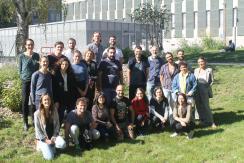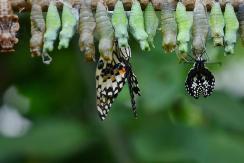COEVOL Multi-Scale Coevolution
Living systems are highly integrated, with a multitude of levels of organization, from molecular and intra-cellular scales to ecosystems. Complex organisms are themselves consortia of macro- and micro-organisms, which work together with their host to build the individual. Yet, each of these organisms can function and evolve in the short term according to its own logic, possibly in conflict with other higher or lower levels, or with other time scales. The once common idea among evolutionists that natural selection results in organisms perfectly adapted to their environment is now severely undermined. Not only because, as the Red Queen explains to Alice, one has to run relentlessly to keep its place in a changing environment, or because past evolutionary history and chance constrain the possibilities of present adaptation, but also because different levels of selection have interests that are generally difficult to reconcile.
Multi-scale coevolution resets classical questions in evolutionary biology
One example, of particular interest is the question of the source of heritable variations. The phenotype of organisms in a population is influenced not only by variations in their nuclear and mitochondrial genomes, the dynamics of which is the object of population genetics, but also more and more patently by the consortium of microbes and genetic elements that constitute its microbiome and virome. The hologenome designates this complex assembly of genetic materials, which obey different rules of transmission and different evolutionary strategies. The ability of symbionts to manipulate host phenotypes or to interfere with each other influences the evolutionary dynamics of all players in ways that are yet poorly understood. In addition, new questions arise, such as the importance of co-adaptation in these systems and their consequences in maintaining cohesive biological systems.
- Symbiosis: a response to and a source of divergent selection
Using a variety of approaches combining experimental evolution, genomic, functional, phenotypic and behavioral data, we aim to test whether symbiosis facilitates diversification and to characterize the underlying microevolutionary processes.
- Ecological networks of horizontal gene transfer
We develop original methods to detect gene transfer and we investigate the factors that influence the routes of gene transfers among microbes but also among insects.
- The interplay between symbiosis, infection and immunity and its evolutionary consequences
We try to understand the intimate interaction of hosts with pathogens, symbionts and transposable elements and how it affects the extended phenotype of the host.
- Transgenerational inheritance and environment changes
We try to decipher the molecular mechanisms that underlie rapid adaptation to environment and to test for transgenerational inheritance of fitness traits.
- Intragenomic conflicts and demography
We are developing models to test whether changes in the demography of the host affect the dynamics of transposable elements.
- The determinism of phenotypic convergence
We study the genomic basis of convergent phenotypic evolution in particular in the case of animals and plants adaptation to increasing temperature and decreasing water.
- Reconciling the tree of life
We develop phylogenetic methods for “reconciling” gene/species or host/symbiont histories and use these methods to explore the bulk of extinct or undescribed species and the history of association of symbiotic microbes with their hosts.
Integrating methods
The methods we use to tackle the questions raised by multi-scale co-evolution extend from theory, modelling and simulation to big data analysis, lab (notably on insects), and to a lesser extent, field activities.
Implication of research, responsibility of researchers and citizen sciences
From our research (some of which have immediate consequences in health, agriculture and ecology) and our concerns about the responsibility of scientists in society, we are committed to promote an “implicative” research. The implicative position means that we try to work on the link between science and society, not only through a one-way communication, applying or explaining our science, but also favoring early discussions on research projects, that may influence our research directions.
Publications
Display of 241 to 270 publications on 709 in total
The Importance of Revisiting Legionellales Diversity
Trends in Parasitology . 34 ( 12 ) : 1027 - 1037
Journal article
see the publicationDe Taranis au Jupiter cavalier à l’anguipède : réflexions autour du substrat celtique dans la religion gallo-romaine
Celtic religions in the roman period. Personal, local, and global . Celtics studies publications ( XX ) : 309-324
Book chapter
see the publicationInfluence of Microbial Symbionts on Plant-Insect Interactions
Insect-Plant Interactions in a Crop Protection Perspective . 81 : 225-257
Book chapter
see the publicationBiodiversité, évolution et fonctionnement des écosystèmes
Les Cahiers des prospectives . hors série : 25-33.
Book chapter
see the publicationMareyMap online: A user-friendly web application and database service for estimating recombination rates using physical and genetic maps
Genome Biology and Evolution . 9 ( 10 ) : 2506-2509
DOI: 10.1093/gbe/evx178
Journal article
see the publicationPitfalls in supermatrix phylogenomics
European Journal of Taxonomy . 283 : 1-25
DOI: 10.5852/ejt.2017.283
Journal article
see the publicationTranscriptomic signatures shaped by cell proportions shed light on comparative developmental biology
Genome Biology . 18 : 29
Journal article
see the publicationGenome sequencing of the behaviour manipulating virus LbFV reveals a possible new virus family
Genome Biology and Evolution . 8 : 3718-3738
DOI: 10.1093/gbe/evw277
Journal article
see the publicationObligate dependence does not preclude changing partners in a Russian dolls symbiotic system
Peer Community In Evolutionary Biology . : 1-2
Journal article
see the publicationManaging cold tolerance and quality of mass-produced Drosophila suzukii flies to facilitate the application of biocontrol through incompatible and sterile insect techniques
Third FAO–IAEA International Conference on Area-wide Management of Insect Pests .
Poster
see the publicationTEtools facilitates big data expression analysis of transposable elements and reveals an antagonism between their activity and that of piRNA genes
Nucleic Acids Research . 45 : 13
DOI: 10.1093/nar/gkw953
Journal article
see the publicationHigh-Throughput Sequencing of Transposable Element Insertions Suggests Adaptive Evolution of the Invasive Asian Tiger Mosquito Towards Temperate Environments
Molecular Ecology . 26 ( 15 ) : 1-14
DOI: 10.1111/mec.14184
Journal article
see the publicationSONIFICATION OF PHYLOGENETIC TREES: LISTENING TO EVOLUTION
Journées d'Informatique Musicale (JIM) 2017 .
Conference paper
see the publicationDeCoSTAR: Reconstructing the ancestral organization of genes or genomes using reconciled phylogenies
Genome Biology and Evolution . 9 ( 5 ) : 1312-1319
DOI: 10.1093/gbe/evx069
Journal article
see the publicationAlgorithms for computing the double cut and join distance on both gene order and intergenic sizes
Algorithms for Molecular Biology . 12 : 16 (11 pages)
Journal article
see the publicationResolution and reconciliation of non-binary gene trees with transfers, duplications and losses
Bioinformatics . 33 ( 7 ) : 980-987
Journal article
see the publicationTranscriptional response to hepatitis C virus infection and interferon-alpha treatment in the human liver
EMBO Molecular Medicine . 9 : 816-834
Journal article
see the publicationElicitation of superparasitization behavior from the parasitoid wasp Leptopilina boulardi by the organophosphorus insecticide chlorpyrifos
Science of the Total Environment . 580 : 907-911
Journal article
see the publicationEvolutionary changes in symbiont community structure in ticks
Molecular Ecology . 26 ( 11 ) : 2905–2921
DOI: 10.1111/mec.14094
Journal article
see the publicationSusceptibility of MED-Q1 and MED-Q3 Biotypes of Bemisia tabaci (Hemiptera: Aleyrodidae) Populations to Essential and Seed Oils
Journal of Economic Entomology . 110 ( 3 ) : 1031 - 1038
DOI: 10.1093/jee/tox100
Journal article
see the publicationSelf and Nonself from a Genomic Perspective: Transposable Elements
Evolutionary Biology: Self/Nonself Evolution, Species and Complex Traits Evolution, Methods and Concepts . 2 ( 5 ) : 111-128
Book chapter
see the publicationEcological networks to unravel the routes to horizontal transposon transfers
PLoS Biology . 15 ( 2 ) : np
Journal article
see the publicationAncestral Genome Estimation Reveals the History of Ecological Diversification in Agrobacterium
Genome Biology and Evolution . 9 ( 12 ) : 3413 - 3431
DOI: 10.1093/gbe/evx255
Journal article
see the publicationComparative Methods for Reconstructing Ancient Genome Organization
Comparative Genomics: Methods and Protocols . : 343 - 362
Book chapter
see the publicationTransposable Element Misregulation Is Linked to the Divergence between Parental piRNA Pathways in Drosophila Hybrids
Genome Biology and Evolution . 9 ( 6 ) : 1450 - 1470
DOI: 10.1093/gbe/evx091
Journal article
see the publicationMaxTiC: Fast Ranking Of A Phylogenetic Tree By Maximum Time Consistency With Lateral Gene Transfers
DOI: 10.1101/127548
Other publication
see the publicationIntegrative modeling of gene and genome evolution roots the archaeal tree of life
Proceedings of the National Academy of Sciences of the United States of America . 114 ( 23 ) : E4602-E4611
Journal article
see the publicationIdentification of misexpressed genetic elements in hybrids between Drosophila-related species
Scientific Reports . 7 : 40618
DOI: 10.1038/srep40618
Journal article
see the publicationLess effective selection leads to larger genomes
Genome Research . 27 : 1016-1028
Journal article
see the publication

